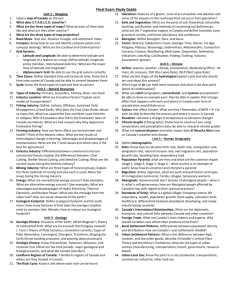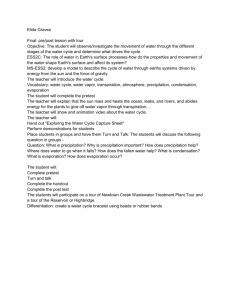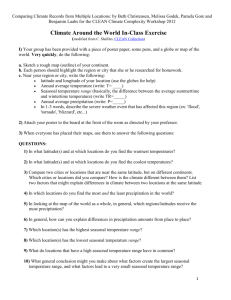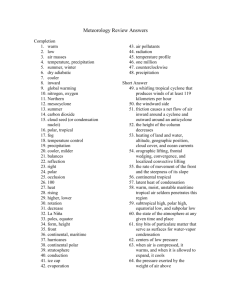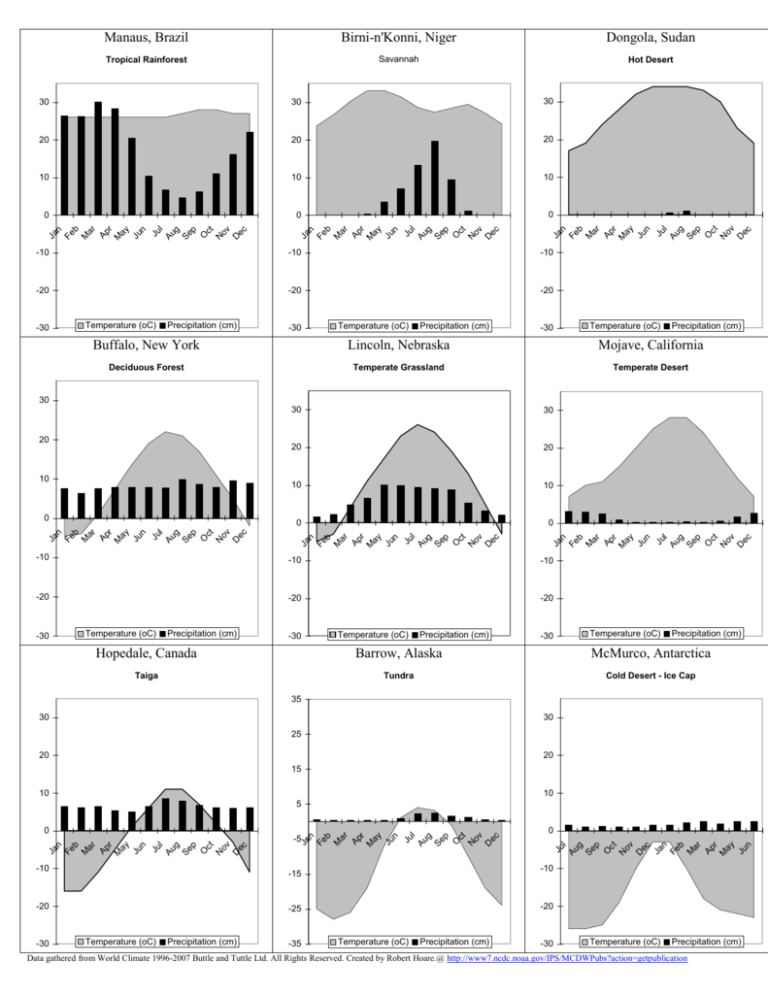
0
0
Ja
D
N
D
N
n
Fe
b
M
ar
Ap
r
M
ay
Ju
n
0
ec
10
ov
10
O
ct
10
Ju
l
Au
g
Se
p
20
Ja
n
Fe
b
M
ar
Ap
r
M
ay
Ju
n
20
ov
ec
20
O
ct
30
Ju
l
Au
g
Se
p
30
Ja
n
Fe
b
M
ar
Ap
r
M
ay
Ju
n
30
-10
-10
-10
-20
-20
-20
-30
Temperature (oC)
Precipitation (cm)
-30
Temperature (oC)
Precipitation (cm)
Temperature (oC)
-30
ec
Hot Desert
D
Savannah
ct
ov
Tropical Rainforest
O
Dongola, Sudan
N
Birni-n'Konni, Niger
Ju
l
Au
g
Se
p
Manaus, Brazil
Precipitation (cm)
Buffalo, New York
Lincoln, Nebraska
Mojave, California
Deciduous Forest
Temperate Grassland
Temperate Desert
-10
-10
-20
-20
-20
-30
Temperature (oC)
Precipitation (cm)
-30
Temperature (oC)
Precipitation (cm)
-30
Temperature (oC)
ec
D
ov
ct
O
N
Ja
D
O
-10
Ju
l
Au
g
Se
p
0
n
0
ec
10
ov
10
ct
20
N
ov
ec
D
ct
O
N
Ju
l
Au
g
Se
p
Ja
n
Fe
b
M
ar
Ap
r
M
ay
Ju
n
0
20
Ju
l
Au
g
Se
p
10
30
Ja
n
Fe
b
M
ar
Ap
r
M
ay
Ju
n
20
30
Fe
b
M
ar
Ap
r
M
ay
Ju
n
30
Precipitation (cm)
Hopedale, Canada
Barrow, Alaska
McMurco, Antarctica
Taiga
Tundra
Cold Desert - Ice Cap
35
30
30
25
20
20
15
10
10
5
-20
-25
Temperature (oC)
Precipitation (cm)
-35
O
ct
N
ov
D
ec
Ja
n
Fe
b
M
ar
Ap
r
M
ay
Ju
n
-10
-15
-20
Ju
l
Au
g
Se
p
ov
ec
D
O
N
Ja
n
Fe
b
M
ar
Ap
r
M
ay
Ju
n
ov
ec
D
O
ct
N
Ju
l
Au
g
Se
p
Ja
n
Fe
b
M
ar
Ap
r
M
ay
Ju
n
-10
-30
ct
0
-5
Ju
l
Au
g
Se
p
0
Temperature (oC)
Precipitation (cm)
-30
Temperature (oC)
Precipitation (cm)
Data gathered from World Climate 1996-2007 Buttle and Tuttle Ltd. All Rights Reserved. Created by Robert Hoare.@ http://www7.ncdc.noaa.gov/IPS/MCDWPubs?action=getpublication
Rainfall
Student Sheet: Butchering the Biome Name: ___________________________________
Procedure
1. Obtain a piece of butcher paper 36 x 48 inches
2. Make an outline of fairly rectangular island that must be at least 1000 x 1500 km
3. Make a legend for dimensions
a. Decide on the number of kilometers East to West, then divide by the number of centimeter. This will give you
the kilometers/centimeter rate (this value goes in your legend).
b. Determine the number of kilometers from North to South.
4. Draw the topography using topographical lines
5. Decide on latitude and longitude for one corner making sure that it is in the middle of an ocean.
c. Determine the latitude on the opposite side of the island.
i. Using the fact that 1o of latitude equals 111 kilometer
ii. (Number of kilometers divided by 111 = number of degrees)
d. Determine the longitude on the opposite side of the island.
i. 1o of longitude equals 111 kilometer x cosine (latitude)
OR
ii. See table
Latitude 1o of longitude
Latitude 1o of longitude
Equator
111 km
50o
72 km
o
10
110 km
60o
56 km
20o
105 km
70o
38 km
30o
96 km
80o
19 km
o
o
40
85 km
90
0
6. Decide on whether your island is tropical, temperate or arctic based on the latitude
7. Locate the coordinates on a world map that has ocean currents. Find the types of currents that surround your island and label
them on your map
8. Determine the direction of the prevailing winds based on the latitude and Coriolis effect
9. Determine the relative levels of precipitation using the following facts.
a. Warm ocean currents will increase the precipitation of the island and cold will decrease the precipitation on the
island.
i. Please note Savannah, Georgia that is hot and humid lies at approximately the same latitude as San
Diego, California that is hot and dry.
ii. The warm/hot Gulf Stream on the east coast of the United States versus the cold California Current on
the west coast.
iii. Warm water encourages evaporation while cold water deters evaporation.
b. 0o and 60o have lots of precipitation due to Hadley cells while 30o is relatively dry.
i. Remember that at the equator and 60o N and S there is a higher level of precipitation due to the Hadley
cells
ii. Remember that at the 30o and 90o N and S there is a lower level of precipitation due to the Hadley cells
c. Remember the windward and leeward rules for mountains.
iii. Water moisture in the air is somewhere in an equilibrium between condensation and evaporation.
iv. As the temperature increases, the evaporation rate increases while the condensation rate decreases. This
decreases the chance of rain for a given amount of moisture in the air.
v. As the temperature decreases, the evaporation rate decreases while the condensation rate increases. This
increases the chance of rain for the same amount of moisture in the air.
10. Based on the temperature and precipitation, predict the types of biomes that will be present. Remember that ecotones or
middle zones exist. For example: Chaparral which is the biome found in the Los Angeles region is somewhere between
Temperate Prairie and desert. Likewise the Tropical Deciduous dry forest is somewhere between Tropical rainforest and
Savanna.
Temperature
Tropical
Temperate
Arctic
Wet
Tropical Rainforest Deciduous Forest
Taiga
Medium
Savanna
Grassland
Tundra
Dry
Hot Desert
Desert
Cold Desert

